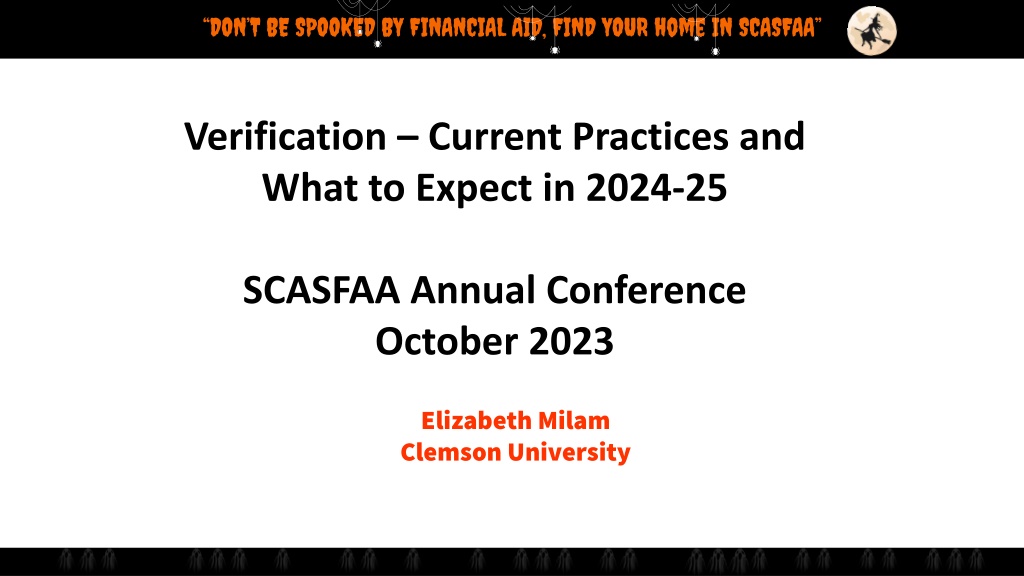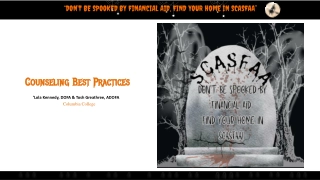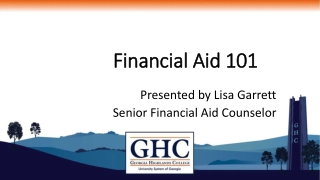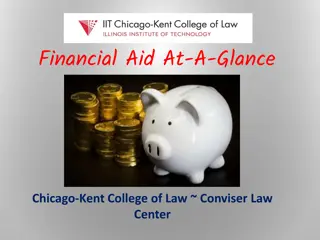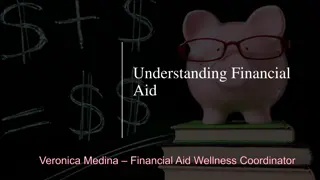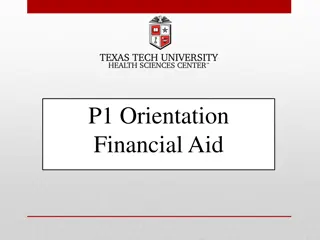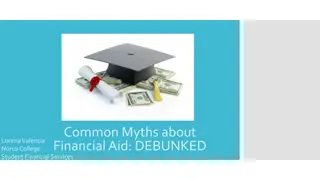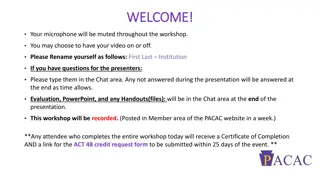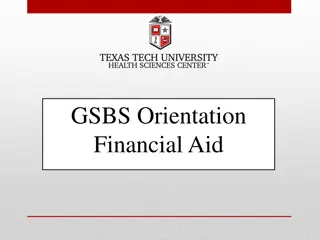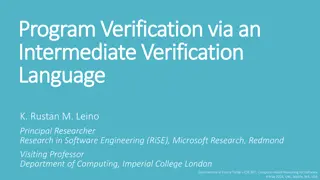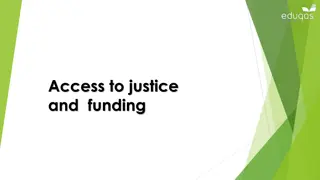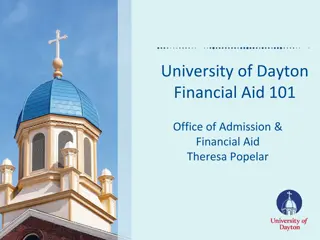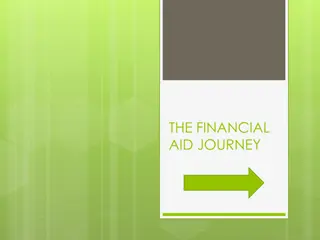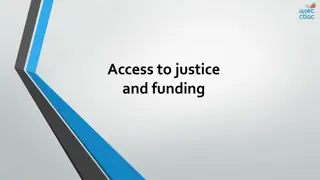Navigating Financial Aid Verification for 2024-25
Learn about the current practices and upcoming changes in financial aid verification for the 2024-25 academic year at the SCASFAA Annual Conference. Discover the key tracking groups, standard requirements, and considerations for students and parents regarding household size and support. Get insights on what to expect and how to prepare for the verification process. Stay informed to make informed decisions about your financial aid journey.
Download Presentation

Please find below an Image/Link to download the presentation.
The content on the website is provided AS IS for your information and personal use only. It may not be sold, licensed, or shared on other websites without obtaining consent from the author. Download presentation by click this link. If you encounter any issues during the download, it is possible that the publisher has removed the file from their server.
E N D
Presentation Transcript
DONT BE SPOOKED BY FINANCIAL AID, FIND YOUR home IN SCASFAA Verification Current Practices and What to Expect in 2024-25 SCASFAA Annual Conference October 2023 Elizabeth Milam Clemson University
DONT BE SPOOKED BY FINANCIAL AID, FIND YOUR home IN SCASFAA Session Goals To review Verification basics To preview changes in Verification for 2024-25 based the FAFSA Simplification Act and the *draft* FAFSA ***Disclaimer: The final FAFSA and FSA Handbook/AVG for 2024-25 have not been released at time of presentation. ***
DONT BE SPOOKED BY FINANCIAL AID, FIND YOUR home IN SCASFAA Verification Tracking Groups Standard Verification Tracking Group (V1) Household size Number in college One of the below: Tax Filer Adjusted Gross Income U.S. income tax paid Untaxed portions of Individual Retirement Account (IRA) distributions Untaxed portions of pensions IRA deductions and payments Tax-exempt interest income Education tax credits Nontax Filer Income earned from work Verification of non-filing status from parents of dependent students, independent students and spouses, if applicable Will not need to be verified if DDX Eliminated from VER in 2024-25 New required VER items for 2024-25: Foreign Earned Income Exclusion Income Earned From Work Income tax items to review: Net Profit or Loss from Schedule C Earned Income Tax Credit
DONT BE SPOOKED BY FINANCIAL AID, FIND YOUR home IN SCASFAA Verification Tracking Groups (cont d) Custom Verification Tracking Group (V4) High school completion status Identity and Statement of Educational Purpose Aggregate Verification Tracking Group (V5) Items from V1 Items from V4 Note: Student selected for V1 or V4 can be changed by CPS to V5.
DONT BE SPOOKED BY FINANCIAL AID, FIND YOUR home IN SCASFAA Number in Household (Family Size in 2024-25) For a dependent student: Student Parents If divorced, the parent with whom the student lived more during the past 12 months (if neither, the parent from whom student received the most financial support when last given) For 2024-25, the parent who provided the most financial support over the past 12 months; if both parents provided the same support or no support, the parent with the greater income and assets Per NASFAA, child support paid is considered support from the parent who pays (not receives) Per NASFAA, the level of support is measured from the biological/legal parent, not the household (stepparent) Include the stepparent if the parent identified above has remarried Include both biological parents if they live together (even if divorced or never married) Include same-sex parents
DONT BE SPOOKED BY FINANCIAL AID, FIND YOUR home IN SCASFAA Number in Household (Family Size in 2024-25) For a dependent student (cont.): Parents other dependent children if they receive more than half their support from parents OR if they would be considered dependent on a FAFSA For 2024-25, the parents dependent children, even if they live apart from the parent because of college enrollment For 2024-25, unborn children are not counted in the family size Other persons if they live with AND receive more than half their support from parents for the entire award year Do not include foster children Cannot use grandparents, aunts/uncles, legal guardians as parents For 2024-25, number in household will be pulled in from tax return, but the applicant can adjust this number
DONT BE SPOOKED BY FINANCIAL AID, FIND YOUR home IN SCASFAA Number in Household (Family Size in 2024-25) For an independent student: Student Spouse Student s children if they receive more than half their support from student For 2024-25, the student s dependent children if they live with the student and receive more than half of their support from the student for the entire award year For 2024-25, unborn children are not counted in family size Other persons if they live with AND receive more than half their support from student the entire award year Do not include foster children
DONT BE SPOOKED BY FINANCIAL AID, FIND YOUR home IN SCASFAA Number in College Include student Do not include parents Include other family members who oare attending at least half time AND oare degree-seeking AND oattend a school that is eligible for federal financial aid Do not include U.S. military academies For 2024-25, the question remains on the FAFSA, but it is not part of the SAI calculation
DONT BE SPOOKED BY FINANCIAL AID, FIND YOUR home IN SCASFAA Tax Issues FAAs must have a fundamental understanding of relevant tax issues that can considerably affect the need analysis. [FAAs] are obligated to know: -whether a person was required to file a tax return, and -what the correct filing statusfor a person should be. Application and Verification Guide (FSAHB)
DONT BE SPOOKED BY FINANCIAL AID, FIND YOUR home IN SCASFAA Filing Requirements Who has to file? 2021 SINGLE (Claims self) Gross income $12,550 MARRIED (Joint) Gross income $25,100 SINGLE (Dependent) Earned income $12,550 or investment income $1,100 These figures are updated annually Who has to file? 2022 SINGLE (Claims self) Gross income $12,950 MARRIED (Joint) Gross income $25,900 SINGLE (Dependent) Earned income $12,950 or investment income $1,150
DONT BE SPOOKED BY FINANCIAL AID, FIND YOUR home IN SCASFAA Filing Requirements Did they file a Schedule 1, 2 or 3? For Schedule 1 See 1040 Lines 8 and 10. If there is a dollar amount on either of these lines, that means a Schedule 1 was filed. You will have to review Schedule 1 to know if the reason it was filed does not constitute a Yes answer. Not used for SNT in 2024-25, but still used for Income Earned from Work and untaxed income. For Schedule 2 See 1040 Line 17. If an amount is on Line 17, then something was added from Schedule 2. You will have to review Schedule 2 to know if an excess advance premium tax credit repayment needs to be subtracted from 1040 Line 22 to calculate Taxes Paid. For Schedule 3 See 1040 Line 20. If an amount is on Line 20, then something was added from Schedule 3. You will have to review Schedule 3 to know if Education Credits need to be added to Additional Financial Information or if there is potentially untaxed income from Retirement Savings Contributions.
DONT BE SPOOKED BY FINANCIAL AID, FIND YOUR home IN SCASFAA Filing Requirements Did they have to file a Schedule 1? This is very important for the Simplified Needs Test EFC (no assets) and Automatic Zero EFC. For FAFSA purposes, a Schedule 1 is required if these line items exist: 1 Refunds of state/local taxes 14 Moving expenses 2 Alimony received 15 Self-employment tax deduction 3 Business income or loss 16 KEOGH/SEP contribution deduction 4 Other gains or losses 17 Self-emp health ins deduction 5 Rent/royalty/partnership/S-Corp/trusts 18 Early withdrawal of savings penalty 6 Farm income or loss 19a Alimony paid 8 Other income (OK if 8.f. Alaska Fund) 21 Tuition and fees deduction 12 Reservist and other business expense 23 Archer MSA deduction 13 Health savings acct deduction 24 Other For 2024-25, Schedule 1 is not used for SNT, now called Applicants Exempt from Asset Reporting, which will be based on Schedules A, B, D, E, F, H, and C (if less than $10K).
DONT BE SPOOKED BY FINANCIAL AID, FIND YOUR home IN SCASFAA Filing Status Which filing status can be used? Tax filers must determine their marital status as of the last day of the year. SINGLE MARRIED FILING JOINTLY MARRIED FILING SEPARATELY HEAD OF HOUSEHOLD (see next slide)
DONT BE SPOOKED BY FINANCIAL AID, FIND YOUR home IN SCASFAA Filing Status Head of household: You paid more than of the cost of keeping up a home for the tax year Your spouse did NOT live in your home during the last 6 months of the year Their absence was NOT because of illness, education, business, vacation, military service, incarceration/detention, AND It was NOT reasonable to assume the person would return to the home after the temporary absence Your home was the main home for your child whom you claim as a dependent
DONT BE SPOOKED BY FINANCIAL AID, FIND YOUR home IN SCASFAA Signature Requirement for Taxes If your office accepts a photocopy of the tax return (1040) instead of a tax return transcript, it must be signed: By at least one filer, OR By a tax preparer who has stamped, typed, signed, or printed their name and their SSN, EIN or PTIN, AND The tax preparer s name must be a person, not a company
DONT BE SPOOKED BY FINANCIAL AID, FIND YOUR home IN SCASFAA Special Tax Situations Make sure you are combining or separating AGI and taxes paid as appropriate for marital status. Use per computer if using tax return transcripts, not recomputed per computer. In the case of an amended income tax return, collect the original return and a signed 1040X. In the case of identity theft where a copy of the 1040 is not available, collect a Tax Return Database View (DRDBV) transcript and a signed statement indicating that the tax filer is a victim of IRS tax- related identity theft and that the IRS has been informed. In the case of non-filers, collect a Verification of Nonfiling. You may accept a signed statement asserting that the person attempted but was unable to get the VNF as long as you have no reason to question that they made a good-faith effort.
DONT BE SPOOKED BY FINANCIAL AID, FIND YOUR home IN SCASFAA Adjusted Gross Income and Taxes Paid Adjusted gross income (AGI) 1040(11) Not Taxable income Taxes paid 1040(22) minus Sch2(2) Not Total tax (do not include other taxes such as self-employment); not Federal income tax withheld For 2024-25, the draft FAFSA released in May had a line-item error that was corrected on the September version (Taxes paid is still Line 22 minus Excess Advance Premium Tax Credit Repayment from Schedule 2)
DONT BE SPOOKED BY FINANCIAL AID, FIND YOUR home IN SCASFAA Income Earned from Work This is not a required Verification item for tax filers, but because it is found on the tax return, it is conflicting data if not corrected. For 2024-24, this is a required Verification item. This is important to calculate the Social Security tax and the employment allowance in the EFC formula. For 2024-25, called Payroll Tax Allowance. 1040(1) + Sch1(3 + 6) + IRS Form 1065/Sch K-1(Box 14, Code A) Use positive values only; do not reduce salary by business or farm losses. If you need to make a correction but cannot determine how much each partner earned, adjust the higher wage earner. (If you divide in half, this will impact the employment allowance.) Not applicable in 2024-25, as they are combined.
DONT BE SPOOKED BY FINANCIAL AID, FIND YOUR home IN SCASFAA Untaxed Income on Tax Documents Tax exempt interest 1040(2a) Untaxed IRA and pension distributions 1040(4a+5a minus 4b+5b) Separated again in 2024-25 Exclude rollovers (this notation shows on 1040 only; not on transcript) Health savings account deduction Sch1(13) Not collected in 2024-25 IRA deductions and SEP/Keogh payments Sch1(16 + 20) Retirement savings contribution credit (if from elective deferred compensation) Sch3(4) Ask for IRS Form 8880 (Line 2), or W-2 Box 12: amounts designated as 401k, 403b, 414h, D, E, F, G, H, and S Not collected in 2024-25
DONT BE SPOOKED BY FINANCIAL AID, FIND YOUR home IN SCASFAA Additional Financial Information Taxable grants and scholarships oStudent should report grants and scholarship that exceed tuition, required fees, book and supplies o1040(1) with SCH and $ on dotted line oThis notation shows on tax return only, not on tax return transcript Education credits Sch3(3) Lumped in with Tax Return Information in 2024-25
DONT BE SPOOKED BY FINANCIAL AID, FIND YOUR home IN SCASFAA Conflicting Data You must examine all documents submitted (even if not requested), such as W-2 forms and military Leave & Earning Statements (LES). These examples do not apply to 2024-25. You must consider all University records (even if not in your department), such as co-op assignments. This example does not apply to 2024-25. Do not request tax documents if DRT (DDX in 2024-25) was used successfully and not changed. Non-verification items that are likely subject to conflicting data (because of available information): income earned from work, grant and scholarships aid, tax-deferred pension, military and clergy allowance, combat pay, co-op earnings. The last four examples do not apply to 2024-25. Non-verification items that are unlikely subject to conflicting data (because no information is available): child support received, child support paid, VA non-educational benefits. The last two examples do not apply to 2024-25.
DONT BE SPOOKED BY FINANCIAL AID, FIND YOUR home IN SCASFAA Summary of Changes for 2024-25 Strong caution This presentation is based on the draft FAFSA and should not be considered final guidance! Instructions on which (divorced) parent to use has changed to the one providing the most support Number in Household is now called Family Size and will be based on IRS dependents (but can be changed) Definition of household member now requires dependent children to live with the parent(s) (unless away at college) Number in College is collected but not used in SAI
DONT BE SPOOKED BY FINANCIAL AID, FIND YOUR home IN SCASFAA Summary of Changes for 2024-25 (cont.) Income tax items that are new required VER items: Foreign Income Tax Exclusion Income Earned from Work Income tax items that need to be reviewed for conflicting data: Net Profit or Loss from Schedule C Earned Income Tax Credit The Simplified Needs Test (SNT) is now called Applicants Exempt from Reporting Assets and is not based on Schedule 1; now based on Schedules A, B, D, E, F, H, and C (if less than $10K)
DONT BE SPOOKED BY FINANCIAL AID, FIND YOUR home IN SCASFAA Summary of Changes for 2024-25 (cont.) Items no longer collected: Child support paid Co-op earnings Tax-deferred pension contributions Military allowances and combat pay Clergy allowances VA non-educational benefits Untaxed worker s compensation and disability benefits Health savings account deduction Other untaxed income including money received or paid on the student s behalf
DONT BE SPOOKED BY FINANCIAL AID, FIND YOUR home IN SCASFAA Summary of Changes for 2024-25 (cont.) Income Earned from Work will no longer be calculated separately for each spouse and will be pulled in by DDX Schools will NOT need to request (or review for conflicting data) W-2 forms to assign Income Earned from Work to each parent, or to collect untaxed income such as military or clergy allowances and tax-deferred retirement contributions W-2 forms should only be needed for: Parents (or students) who filed a MFJ tax return and are now separated/divorced/widowed/remarried OR Non-tax filers with wages
DONT BE SPOOKED BY FINANCIAL AID, FIND YOUR home IN SCASFAA Conclusion If DDX is successfully used by a tax filer, and no data element is changed, it appears that Verification will be eliminated for this applicant Number in Household (Family Size) is pulled from the tax return (based on IRS dependents) Number in College is eliminated AGI, taxes paid, and income earned from work are pulled from tax return All untaxed income has been eliminated that cannot be pulled from tax return So nothing left to VER, right? Verification will still be needed for applicants who cannot use DDX because of marital status mismatches
DONT BE SPOOKED BY FINANCIAL AID, FIND YOUR home IN SCASFAA Resources Federal Register 9/19/23 and GEN-23-12 for 2024-25 Verification Federal Student Aid Handbook, Verification and Application Guide IRS publication 17 FAFSA pdf of form and all instructions NASFAA s Verification Data and Federal Tax Forms Comparison (Available at nasfaa.org if your institution is a member) IronBridge sessions by Robert Weinerman (attend at conferences)
DONT BE SPOOKED BY FINANCIAL AID, FIND YOUR home IN SCASFAA Questions?
DONT BE SPOOKED BY FINANCIAL AID, FIND YOUR home IN SCASFAA Thank you for attending! Elizabeth Milam Clemson University milamm@clemson.edu
